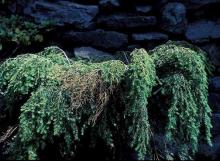Cause Phytophthora cinnamomi, P. cactorum, P. cryptogea, and P. drechsleri, fungus-like microorganisms found under wet conditions such as prolonged periods of soil saturation. Generally called water molds because they produce a swimming spore stage (zoospore) that is attracted to roots. They survive as various spores in the soil, container media or infected roots. Western hemlock (T. heterophylla) and mountain hemlock (T. mertensiana) are highly susceptible, particularly in poorly drained areas of a nursery. There are many other potential hosts of these organisms.
Symptoms Seedlings' lateral roots are fewer and shorter than normal. Normally white cambial root tissue becomes reddish brown as the organism advances up the roots into the root crown. There may be no visible aboveground symptoms the first year of infection. The spring after infection, chlorosis, stunting, wilting, and browning of the needles can occur. Symptoms can be confused with soil compaction, mechanical damage, or nematode damage.
Cultural control
- Improve drainage in low areas.
- Remove and destroy all infected plants and plant debris.
- Plant resistant or tolerant hosts in low areas.
- Avoid reusing pots from a previous crop for propagation. If pots must be reused then wash off all debris and soak in a sanitizing solution or treat with aerated steam for 30 min.
Chemical control Use fungicides as preventative treatments. The Group 4 and P7 fungicides used to manage Phytophthora do not kill this organism. They can only prevent establishment of the organism before it gets into the plant. They can also prevent continued growth if the organism is already inside the plant thereby delaying symptoms that might have developed. Once chemical activity has subsided with time, the organism can resume growth within infected plants. Rotate fungicides from different groups that have different modes of action for resistance management.
- ArborFos is registered for tree injections. The number of capsules used is based on tree size. Group P7 fungicide.
- Fosphite at 1 to 2 quarts/100 gal water is not specifically labeled but can be used if not phytotoxic. Do not use copper products within 20 days of treatment and do not use spray adjuvants. Group P7 fungicide. 4-hr reentry.
- Phospho-Jet at 1 to 2 quarts/100 gal water as a soil drench. Group P7 fungicide. 4-hr reentry.
- Subdue MAXX or Mefenoxam 2 AQ are not specifically labeled but can be used if not phytotoxic. Group 4 fungicide. 48-hr reentry.
- Terrazole 35 WP at 3.5 to 10 oz/100 gal water. Group 14 fungicide. 12-hr reentry.
Reference Hamm, P.B., Campbell, S.J., and Hanson, E.M. 1990. Growing Healthy Seedlings: Identification and Management of Pests in Northwest Forest Nurseries. USDA Forest Service Special Publication 19. Corvallis, OR: Oregon State University Forest Research Laboratory.





